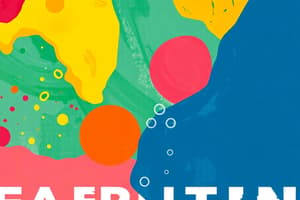Podcast
Questions and Answers
What is the primary focus of Chapter 1 of the course?
What is the primary focus of Chapter 1 of the course?
- Teaching-Learning in Blended and Online Education
- Basics of Computer-Mediated Instructional Design (correct)
- The Role of Artificial Intelligence in Education
- Assessments and Evaluations in Online Learning
What is the main concern of 'Technology and Learning for All'?
What is the main concern of 'Technology and Learning for All'?
- Inclusive approaches to technology integration (correct)
- Technology's impact on teacher workload
- Government policies on technology in education
- Cost-effectiveness of technology integration
What is the primary application of instructional design?
What is the primary application of instructional design?
- Business management and marketing
- Medical and healthcare education
- Distance education and online learning (correct)
- Environmental and conservation education
What influences instructional design strategies?
What influences instructional design strategies?
What is the focus of Unit 2 of the course?
What is the focus of Unit 2 of the course?
Why is assessing learners' needs important?
Why is assessing learners' needs important?
What is the purpose of defining instructional goals and objectives?
What is the purpose of defining instructional goals and objectives?
What is the primary focus of distance education?
What is the primary focus of distance education?
What is the primary focus of Chapter 3?
What is the primary focus of Chapter 3?
Which chapter explores the importance of designing for diverse learners?
Which chapter explores the importance of designing for diverse learners?
What is the main concern addressed in Chapter 5?
What is the main concern addressed in Chapter 5?
Which of the following is NOT a principle of Universal Design for Learning (UDL)?
Which of the following is NOT a principle of Universal Design for Learning (UDL)?
What is the primary focus of Chapter 6 (according to the provided content)?
What is the primary focus of Chapter 6 (according to the provided content)?
Which of the following is a core principle of Universal Design for Learning (UDL)?
Which of the following is a core principle of Universal Design for Learning (UDL)?
What is the main concern addressed in Chapter 4?
What is the main concern addressed in Chapter 4?
Which of the following is a critical aspect of distance education?
Which of the following is a critical aspect of distance education?
Flashcards are hidden until you start studying
Study Notes
Chapter 1: Basics of Computer-Mediated Instructional Design
- Technology has transformed the way we learn and teach, with a significant impact on 21st-century education.
- Inclusive approaches to technology integration ensure that all learners have equal access to education.
- Instructional design is the process of creating learning experiences that meet specific goals and objectives, which is crucial in distance education.
- Various technologies and media are used for content delivery, instruction, and assessments in different learning modalities, including face-to-face, online, distance, and blended learning.
- Theories and models of instructional design, such as ADDIE, Dick and Carey, and Keller's ARCS, guide effective instructional design.
- Technology influences instructional design strategies, making it essential to adapt design principles to different learning modalities.
- Instructional design principles must be adapted to face-to-face, online, distance, and blended learning environments.
Chapter 2: Teaching-Learning in Blended and Online Education
- Assessing learners' needs and designing contextually relevant content is critical in blended and online education.
- Clear learning objectives aligned with the course content are essential for effective instructional design.
- Distance education is based on the concept of learning at a distance, with various technologies used for content delivery and assessments.
- Technologies used in distance education include learning management systems, online collaboration tools, and multimedia resources.
- Instructional design approaches for distance education must be tailored to the specific learning context.
- Internet-based distance education presents unique opportunities and challenges for teaching, learning, assessment, and evaluation.
- Copyright considerations must be addressed when using digital resources in distance education and blended learning.
Chapter 3: Principles of Universal Design for Learning
- Universal Design for Learning (UDL) promotes accessibility and inclusivity by providing multiple means of representation, expression, and engagement.
- UDL principles include providing options for perception, language, and symbols, as well as options for comprehension and navigation.
- The need for UDL arises from the diversity of learners, highlighting the importance of designing for accessibility.
- Universal design principles can be applied to instructional design, leveraging technology to create accessible learning experiences.
- UDL principles can be implemented in instructional design by providing multiple means of representation, expression, and engagement.
Chapter 4: Teaching-Learning in Distance and Online Education
- Distance education concepts, including the importance of technology and instructional design, are critical in online and distance learning contexts.
- Technologies used in distance education, such as learning management systems and online collaboration tools, are essential for effective instruction and assessment.
- Instructional design methods for distance education must be adapted to the specific learning context, taking into account the unique challenges and opportunities of online and distance learning.
- Internet-based distance education requires careful consideration of teaching, learning, assessment, and evaluation strategies.
- Copyright considerations must be addressed when using digital resources in distance education and blended learning.
Chapter 5: Integration of Assistive Technologies in Educational Content Development
- Assistive technologies, including adaptive software and hardware, support diverse learners by providing equal access to education.
- Differentiating instruction, UDL, and SIOP (Sheltered Instruction Observation Protocol) are key principles and practices that support inclusive education.
- Assistive technologies can be integrated into educational content development to create accessible and inclusive learning experiences.
Studying That Suits You
Use AI to generate personalized quizzes and flashcards to suit your learning preferences.




